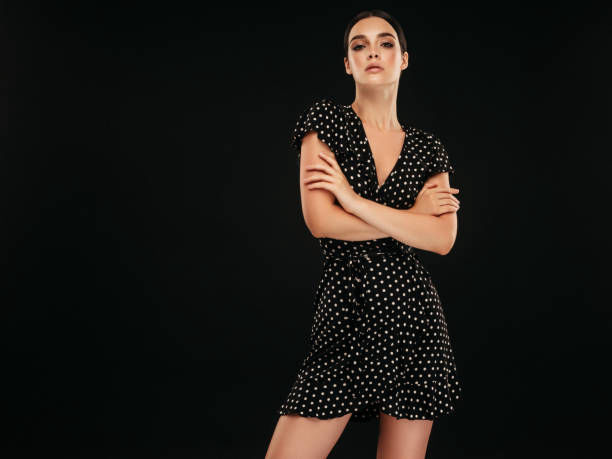Fashion is not just about clothing — it’s a form of language, expressing personality, confidence, and emotion through fabric and form. Among the most enduring and recognizable silhouettes in women’s fashion is the babydoll dress. Characterized by its short hemline, high waistline, and flowy, youthful design, the babydoll dress has evolved from mid-20th-century nightwear into a beloved global fashion statement that transcends generations.
Whether worn casually, formally, or as a symbol of empowerment, the babydoll dress continues to redefine femininity and comfort in contemporary wardrobes. This in-depth article explores the origins, structure, variations, cultural influence, and styling versatility of the babydoll dress, highlighting why it remains one of the most iconic garments in women’s fashion history.
1. The Origin and Evolution of the Babydoll Dress
The babydoll dress first emerged during the 1940s, an era when wartime restrictions on fabric and materials influenced fashion trends. Designers began creating shorter, lighter garments for women that used less fabric while maintaining charm and femininity. The term “babydoll” itself became widely recognized after the release of the 1956 film Baby Doll, starring Carroll Baker. Her wardrobe, designed by William Travilla, featured short, flouncy nightgowns that captured both innocence and allure — setting the foundation for what would become known as the babydoll style.
By the 1960s, the babydoll silhouette transitioned from lingerie to mainstream clothing. The youth revolution, led by designers like Mary Quant, embraced shorter hemlines and playful silhouettes that celebrated freedom and individuality. The babydoll dress perfectly embodied that spirit — playful yet bold, feminine yet liberating. Over time, it became a fashion staple, appearing in every major decade with new interpretations reflecting cultural shifts.
2. Defining Characteristics of a Babydoll Dress
Although modern variations exist, certain design elements define the classic babydoll dress silhouette.
| Feature | Description |
|---|---|
| Empire Waistline | A high waistline just below the bust, creating a flattering and youthful shape. |
| Short Hemline | Typically above the knee, adding playfulness and freedom of movement. |
| Loose Fit | Flowing fabric that flares from the bust downward, emphasizing comfort. |
| Light Fabrics | Common materials include chiffon, cotton, satin, or lace for a soft, delicate drape. |
| Decorative Details | Often features ruffles, bows, lace trims, puff sleeves, or gathered busts. |
These features give the babydoll dress its instantly recognizable “doll-like” charm while maintaining versatility across body types.
3. Symbolism and Fashion Psychology Behind the Babydoll Dress
Beyond aesthetics, the babydoll dress carries symbolic and psychological meaning. It represents youthfulness, innocence, and playful femininity, but also confidence and control over one’s image. During the women’s liberation movement, for instance, wearing a short and flowy dress was an act of rebellion against restrictive fashion norms that dictated how women should appear.
Psychologically, the loose structure of a babydoll dress creates a sense of comfort and freedom, allowing movement without constraint — a stark contrast to the corsets and structured silhouettes of earlier centuries. This comfort appeals to modern women who value both style and practicality.
4. Materials and Fabrics Used in Babydoll Dresses
The choice of fabric plays a vital role in determining how a babydoll dress moves, feels, and looks. The lightweight nature of most materials complements its airy structure.
| Fabric Type | Texture & Appearance | Best Use |
|---|---|---|
| Chiffon | Sheer, floaty, and elegant | Formal occasions, summer wear |
| Cotton | Soft, breathable, and durable | Casual and everyday wear |
| Satin | Smooth, glossy finish | Evening or party wear |
| Lace | Intricate and feminine | Romantic or bridal styles |
| Linen | Natural, airy, and crisp | Warm climates, bohemian looks |
| Organza | Structured and semi-sheer | Fashion-forward or dramatic designs |
These fabrics determine not only the dress’s aesthetic but also its suitability for different climates and events.
5. Types and Variations of Babydoll Dresses
Over the years, designers have reinterpreted the babydoll silhouette into numerous variations suitable for diverse occasions and personal tastes.
| Type of Babydoll Dress | Description | Ideal For |
|---|---|---|
| Classic Babydoll | Traditional empire waist with flowy skirt and simple design | Everyday wear |
| Lace Babydoll | Features lace overlays and trims for added romance | Date nights, evening wear |
| Boho Babydoll | Incorporates ethnic prints, tassels, and loose sleeves | Festivals, beach outings |
| Modern Minimalist | Clean lines, solid colors, less embellishment | Urban fashion lovers |
| Tiered Babydoll | Layered skirt design for extra volume | Parties, fashion events |
| Long-Sleeve Babydoll | Balanced silhouette for cooler seasons | Fall or winter styling |
| Off-Shoulder Babydoll | Elegant neckline emphasizing shoulders | Summer or casual wear |
| Velvet Babydoll | Rich, textured fabric for luxury appeal | Evening and holiday wear |
This adaptability has made the babydoll dress a favorite among designers and consumers alike, blending effortlessly across different fashion eras.
6. The Babydoll Dress in Different Fashion Eras
1940s–1950s: Birth and Early Popularity
Initially introduced as sleepwear, the babydoll gained attention for its delicate charm and light construction.
1960s: The Youth Revolution
Designers like Mary Quant and André Courrèges transformed the babydoll into an everyday outfit. The shorter hem symbolized liberation and rebellion against conservative norms.
1980s–1990s: Punk Meets Feminine
The rise of grunge brought a darker, edgier side to the babydoll dress. Artists like Courtney Love popularized pairing babydolls with boots and fishnets — a style that blended softness with rebellion.
2000s–Today: The Modern Revival
Today’s babydoll dresses have become versatile staples found on runways, red carpets, and streetwear collections alike. Fashion houses reinterpret the design with sustainable fabrics and contemporary silhouettes that maintain the playful DNA of the original.
7. The Anatomy of a Perfect Babydoll Dress
To understand what makes a babydoll flattering, one must look at the design structure.
| Part | Purpose / Design Logic |
|---|---|
| Bodice | Fitted near the bust to provide shape and definition. |
| Empire Seam | Positioned just below the bust, creating a high-waisted illusion. |
| Skirt | Flowy, often A-line or circular cut for movement and comfort. |
| Sleeves | Can range from puff, cap, or bell styles to add character. |
| Neckline | Square, V-neck, sweetheart, or round — defines the overall tone of the outfit. |
This combination of structure and flow ensures the babydoll complements various body types without sacrificing comfort.
8. Babydoll Dresses and Body Shapes
One of the most appealing qualities of the babydoll dress is its universality — it flatters nearly every figure.
| Body Shape | Why It Works | Styling Tip |
|---|---|---|
| Pear Shape | Emphasizes bust and hides hips | Choose A-line styles with detailing on the bodice |
| Apple Shape | Skims over the waistline | Opt for empire waistlines and flowy fabrics |
| Hourglass | Highlights bust while maintaining balance | Select structured or belted versions |
| Rectangle | Adds volume and femininity | Ruffles or layered skirts create curves |
| Petite | Shorter hemline elongates legs | Go for above-the-knee styles with minimal layers |
The adaptability of this silhouette has made it a go-to choice for designers seeking inclusivity in fashion.
9. Styling a Babydoll Dress: Tips for Every Occasion
A babydoll dress can be styled in countless ways — from sweet and casual to bold and glamorous.
Casual Look
Pair a cotton or linen babydoll with sneakers or sandals. Add a denim jacket or crossbody bag for an effortless day outfit.
Chic Streetwear
Layer an oversized babydoll with a leather jacket and ankle boots. Accessorize with sunglasses and minimal jewelry for urban edge.
Romantic Evenings
Opt for lace or satin fabrics in pastel or jewel tones. Pair with strappy heels and delicate jewelry for a dreamy look.
Formal Events
Structured or velvet babydoll dresses can serve as eveningwear when styled with heels, clutch bags, and statement earrings.
Bohemian Style
Choose printed or embroidered babydolls with earthy accessories like beaded necklaces, wide-brim hats, or gladiator sandals.
This flexibility makes the babydoll dress one of the most versatile garments in a modern wardrobe.
10. Accessorizing Your Babydoll Dress
Accessories complete the look, balancing playfulness with sophistication.
| Accessory Type | Recommended Choice |
|---|---|
| Footwear | Sneakers for casual, heels for formal, boots for edgy looks |
| Jewelry | Layered necklaces or dainty earrings enhance femininity |
| Bags | Mini handbags or crossbody purses maintain proportion |
| Outerwear | Denim, leather, or cropped cardigans complement the shape |
| Belts | Add waist definition for more structured styling |
Choosing the right accessories transforms the babydoll from daywear to statement fashion effortlessly.
11. Babydoll Dresses in Popular Culture
From cinema to celebrity fashion, babydoll dresses have made recurring appearances.
- 1960s: Worn by Twiggy and Brigitte Bardot as icons of mod fashion.
- 1990s: Adopted by Courtney Love and the riot grrrl movement as feminist rebellion attire.
- 2000s–Present: Celebrities like Ariana Grande, Zendaya, and Lily-Rose Depp often feature babydoll-inspired designs, symbolizing timeless femininity reimagined for the modern era.
These cultural moments highlight the dress’s unique power to adapt to societal trends while maintaining its playful essence.
12. Seasonal Styling Guide
| Season | Recommended Fabric & Color | Styling Advice |
|---|---|---|
| Spring | Floral prints, chiffon | Pair with sandals and pastel accessories |
| Summer | Cotton, linen | Opt for sleeveless or off-shoulder designs |
| Autumn | Velvet, thicker cotton | Layer with tights and ankle boots |
| Winter | Wool-blends, long sleeves | Add coats, scarves, and heeled boots |
No matter the season, the babydoll dress remains relevant — adaptable to both weather and mood.
13. Sustainability and Ethical Production
With fashion’s growing awareness of sustainability, many brands now produce eco-friendly babydoll dresses using organic cotton, recycled polyester, and ethical labor practices. These initiatives align with modern consumers’ preference for slow fashion — clothing that lasts longer, impacts less, and supports ethical craftsmanship.
Choosing sustainable babydolls not only benefits the planet but also promotes mindful consumerism, merging beauty with responsibility.
14. Maintenance and Care
Proper care ensures longevity and preserves the beauty of your babydoll dress.
- Read Labels: Always follow washing instructions for delicate fabrics.
- Hand Wash Preferred: Especially for lace, chiffon, or satin.
- Avoid Direct Sunlight: To prevent color fading.
- Steam Instead of Iron: Maintains texture and prevents burns.
- Store Properly: Hang dresses or fold them gently to prevent wrinkles.
With careful handling, a quality babydoll dress can remain a wardrobe favorite for years.
15. Babydoll Dresses and Empowerment
What makes the babydoll dress truly special is how it has transcended its original purpose. Once seen as girlish or even controversial, it’s now celebrated as a symbol of self-expression and empowerment. Women across all ages embrace it not just for fashion but for the statement it makes — one of independence, confidence, and comfort in femininity.
It’s not about dressing to please others but about reclaiming softness as strength. That duality — delicate yet powerful — defines the modern appeal of the babydoll dress.
16. Future of Babydoll Fashion
Fashion evolves cyclically, and the babydoll dress continues to inspire new interpretations. Future trends may feature:
- Smart textiles that adapt to temperature and movement.
- Gender-fluid designs breaking traditional stereotypes.
- Sustainable couture, merging artistry with eco-consciousness.
- Cultural fusion — blending traditional prints with modern cuts.
This evolution ensures the babydoll dress will remain not just relevant, but revolutionary.
Conclusion
The babydoll dress represents more than a trend — it’s a story of evolution, empowerment, and elegance. From its origins in mid-century nightwear to a symbol of fashion freedom, the dress has adapted beautifully to modern sensibilities while retaining its essence: lightness, youth, and joy.
Whether worn for casual outings, romantic evenings, or as a statement of individuality, the babydoll dress continues to charm wearers across generations. Its ability to balance comfort with beauty, innocence with sophistication, and history with modernity makes it an enduring icon in fashion.
So, the next time you slip into a babydoll dress, remember — you’re not just wearing a piece of clothing. You’re wearing a legacy of freedom, femininity, and artistic expression.
Frequently Asked Questions (FAQs)
1. What is a babydoll dress?
A babydoll dress is a short, loose-fitting garment with a high empire waistline, designed for comfort and a youthful, feminine silhouette.
2. What fabrics are best for babydoll dresses?
Common materials include cotton, chiffon, lace, satin, and linen — each offering unique textures and seasonal suitability.
3. Can babydoll dresses suit all body types?
Yes. Their flowy structure flatters every shape by emphasizing the bust and skimming the waist and hips.
4. How can I style a babydoll dress for formal events?
Opt for satin or velvet versions with heels, clutch bags, and elegant jewelry for a sophisticated appearance.
5. Is the babydoll dress still fashionable today?
Absolutely. It remains a timeless wardrobe essential, loved for its comfort, versatility, and effortlessly stylish charm.











